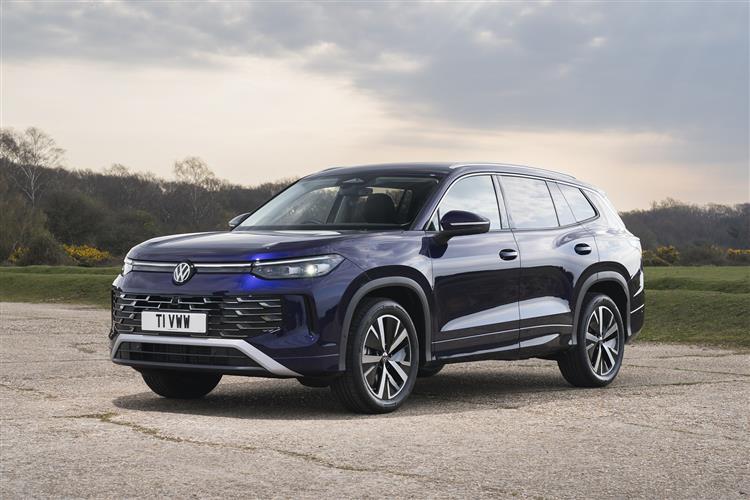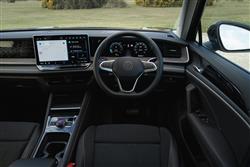NO LONGER WOLFSBURG IN SHEEP'S CLOTHING (some text hidden) --NONE--
By Jonathan Crouch
The Tayron is a sharper-looking kind of Volkswagen seven-seat family SUV. Jonathan Crouch drives it.
Ten Second Reviewword count: 40
Filling the gap in Volkswagen's SUV range between the Tiguan and the Touareg, the Tayron is a much more convincing seven-seat family crossover than its Tiguan Allspace predecessor. And brings a premium feel to the mainstream brand seven-seat crossover segment.
Backgroundword count: 131
'The Tayron is a bona fide Volkswagen'. This slightly strange statement from the brand's CEO conceals a veiled reference that perhaps its predecessor wasn't. That car, the Tiguan Allspace (which sold for seven years from 2017) was nothing more than a slightly stretched Tiguan with an extra seating row; in a segment where customers expect seven-seat mid-sized SUVs to be bespoke designs. Like the Peugeot 5008, the Nissan X-Trail and the Skoda Kodiaq. The Tayron shares virtually all of its engineering with the Kodiaq - and of course with the Tiguan. But is, Volkswagen assures us, very much its own car with a unique, quite premium look inside and out that supposed to better fill the brand's SUV segment gap between the Tiguan and the Touareg. Let's take a closer look.
Driving Experienceword count: 555
As we'll tell you throughout this review, Volkswagen's tried its hardest to make this Tayron very much a stand-alone product, but one area where this SUV couldn't be any different from its Tiguan stablemate was in terms of engineering. The drivetrains, all paired of course to DSG auto transmission, are pretty much exactly as you'll find them in that sister model - and very similar to those in that Volkswagen's Skoda Kodiaq close cousin. Which means a defiant diesel offering - or if you really want to move on from that, the latest in petrol Plug-in Hybrid tech. Unfortunately, like its VW Group segment stablemates, the Tayron lacks the self-charging full-Hybrid technology that you'd find in this sector with rivals from Kia, Hyundai, Lexus and Toyota - and to some extent from Peugeot too. Why the Wolfsburg conglomerate has never developed such an engine for mid-sized models in this era is difficult to understand. Your dealer might tell you that the entry-level 150PS 48V mild hybrid 1.5 eTSI petrol engine offers much the same sort of thing as a proper self charging full-Hybrid, but it doesn't, as an efficiency figure comparison will demonstrate. As usual with a mild hybrid, the eTSI engine works with a 48V belt starter generator and a 48V lithium-ion battery that gets charged through regenerative braking energy delivered when coasting or off-throttle. 0-62mph takes 9.4s en route to 127mph. What this engine really needs is a bit more mid-range pulling power - which is possibly why Volkswagen has decided to ignore the current anti-black pump fuel zeitgeist and continue to offer its 2.0-litre TDI 150PS diesel unit in this segment. This unit's benchmark performance figures (62mph in 9.7s en route to 129mph) are much like those of the eTSI, but the 360Nm torque figure that accompanies TDI progress is nearly 50% gutsier than this petrol model can manage. Hence this engine's improvement in braked towing capacity from 1.8 to 2.0-tonnes. If you need to tug along something heavier, you'll be pointed towards the top 2.0 TSI petrol powerplant, offered in 204PS and 265PS forms and (for our market) the only unit in the range that's paired with 4MOTION 4WD - which explains the much higher 2,400kg braked towing weight capability. In this form, the Tayron's quite a rapid thing too, the 265PS 2.0-litre model able to make 62mph in 6.1s en route to 149mph. We mentioned 4WD; that's something you still can't have in a Plug-in Hybrid Volkswagen SUV of any kind - which is odd because partner brand Audi standardises 4WD with basically the same PHEV technology. As with the Tiguan, eHybrid versions of this Tayron are based around the 1.5-litre petrol engine and come in two versions, with either 204PS or 272PS. Both feature a large 19.7kWh battery and offer respective EV range figures of either 75 or 71 miles. Enough, Volkswagen reckons, to allow most families to use a Tayron eHybrid much like an EV. You won't get anywhere close to those EV range figures of course if you use all the performance on offer: the 204PS version makes 62mph in 8.6s en route to 130mph; for the 272PS variant it's 7.2s and 134mph. As with the Tiguan eHybrid, the Tayron PHEVs use a 6-speed DSG auto gearbox, replacing the 7-speed DSG auto used in the conventionally-engined models.
To see the full road test text contact us on 0330 0020 227
Pictures (high res disabled)

.jpg)
|
.jpg)
|
.jpg)
| |||
.jpg)
|
.jpg)
|
.jpg)
| |||
.jpg)
|
.jpg)
|
.jpg)
| |||
.jpg)
|

|
Statistics (subset of data only)
Min |
Max |
|
Price: |
£40,130.00 (At 13 May 2025, Life 1.5 eTSI) |
£50,210.00 (At 13 May 2025, eHybrid R-Line Edition) |
CO2 (g/km): |
139 (1.5 eTSI) |
9 (eHybrid 204PS) |
Max Speed (mph): |
119 (1.5 eTSI) |
149 (2.0 TSI 265PS) |
0-62 mph (s): |
9.4 (1.5 eTSI) |
6.1 (2.0 TSI 265PS) |
Electric WLTP-Rated Driving Range (miles): |
71 |
|
Combined Mpg: |
46.5 (1.5 TSI Life) |
696 (eHybrid 272PS) |
Length (mm): |
4792 |
|
Width (mm): |
1866 |
|
Height (mm): |
1666 |
|
... and 3 other stats available | ||
Scoring (subset of scores)
Category: Crossover or SUV 4x4s
| Performance | |
| Handling | |
| Comfort | |
| Space | |
| Styling, Build, Value, Equipment, Depreciation, Handling, Insurance and Total scores are available with our full data feed. | |



